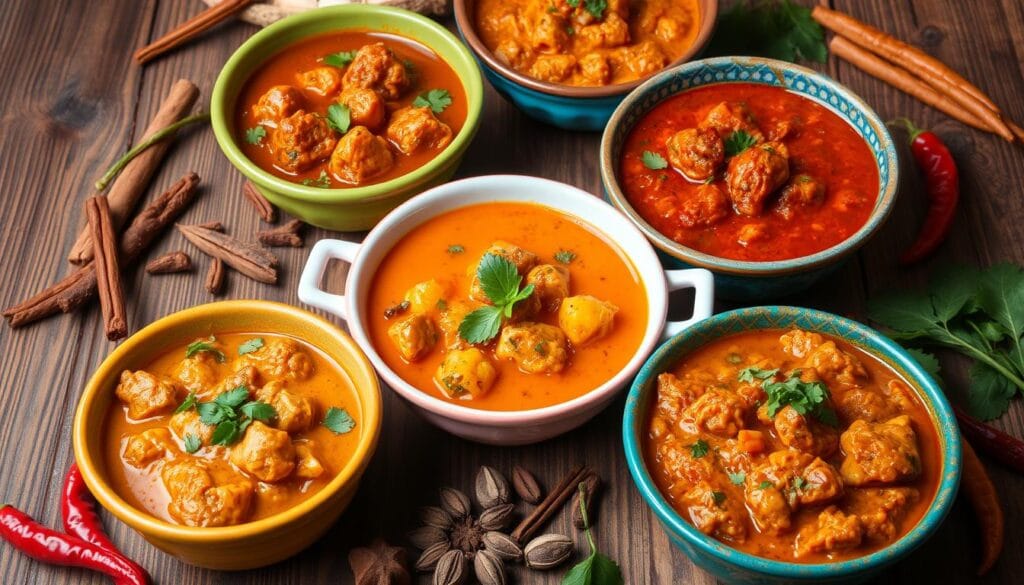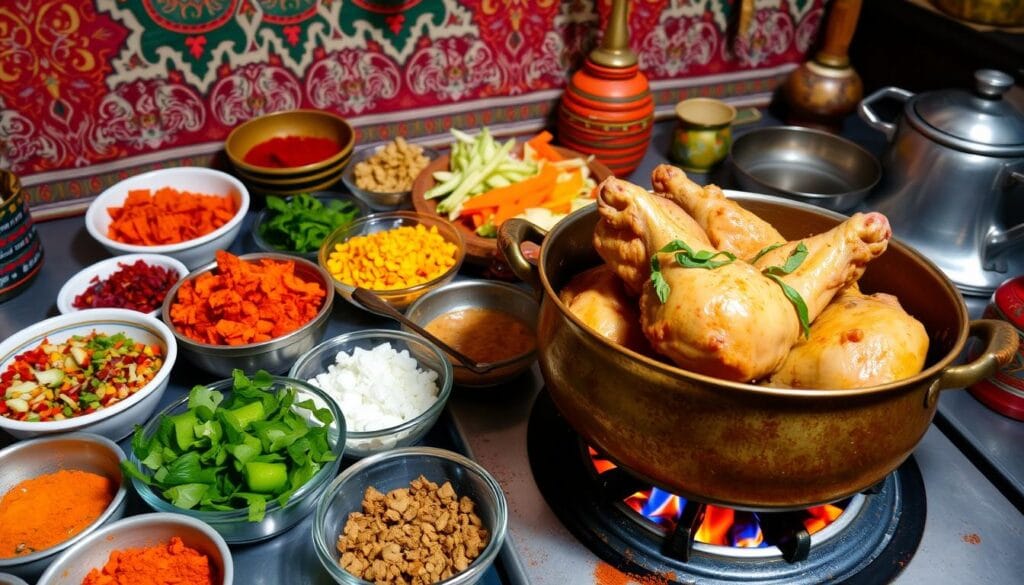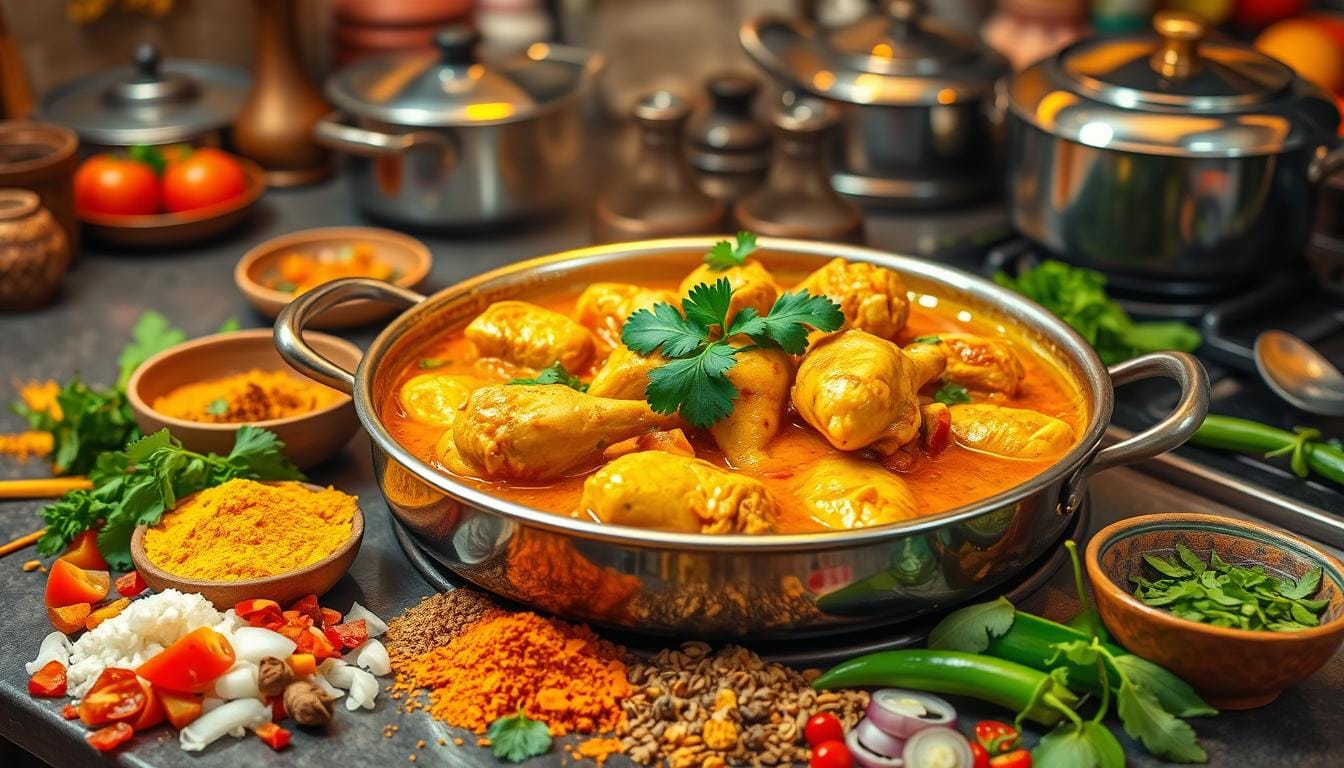The smell of spices filled my kitchen, reminding me of a trip to Mumbai. There, street vendors made authentic Indian chicken stews that won my heart. Each pot tells a story of tradition, warmth, and magic that crosses borders.
Indian chicken stew recipes are more than food. They’re a journey of flavours that brings comfort and excitement to Canadian homes. From Delhi’s streets to Canadian kitchens, these dishes mix amazing flavours that excite and warm us.
If you love spices or want to try something new, Indian chicken stew is perfect. Each recipe brings its own special touch, offering a mix of the exotic and the familiar.
Table of Contents
Understanding the Heritage of Indian Chicken Stew Recipes
Indian chicken stews are a journey through centuries of rich traditions. These recipes show the diversity of cooking and culture in the Indian subcontinent.
Making indian curry recipes is more than cooking. It’s celebrating flavours, techniques, and family heritage that lasts through generations.
Regional Variations Across India
Every region in India adds its own twist to chicken stews. This creates a colourful mix of culinary traditions:
- North Indian Butter Chicken Stew: Creamy, rich with tomato-based gravy
- South Indian Coconut Chicken Stew: Light, tangy with coconut milk base
- Bengali Chicken Jhol: Lighter, spicier preparation
- Goan Chicken Xacuti: Complex spice blend with Portuguese influences
Traditional Cooking Methods and Techniques
Authentic Indian chicken stews use old cooking methods:
- Slow-cooking to develop deep flavours
- Tempering spices in hot oil
- Layering ingredients for complex taste profiles
- Using traditional clay or cast-iron cookware
Essential Spice Combinations
“Spices are the soul of Indian cooking” – Chef Madhur Jaffrey
The secret of desi chicken stew is in its spice blends. Key spices include:
- Garam masala
- Turmeric
- Cumin
- Coriander
- Cardamom
These spices add flavour and offer health benefits. They show the holistic nature of traditional Indian cuisine.
Essential Ingredients for Authentic Indian Chicken Stew
Making a delicious chicken curry stew is more than just mixing ingredients. It’s about choosing the right parts to make a dish truly special.
Knowing the key ingredients is key to making a real chicken masala stew. This dish should truly show off Indian flavors. Let’s look at the must-haves for your cooking.
Fresh Herbs and Aromatics: The Flavour Foundation
Choosing the best fresh herbs and aromatics is crucial. They bring life to your chicken curry stew. Here are the essential items:
- Fresh cilantro leaves
- Ginger root
- Garlic cloves
- Green chilies
- Curry leaves
Selecting the Perfect Chicken Cuts
The chicken cut you choose can greatly affect your stew. Here are some options for the best taste and texture:
| Chicken Cut | Flavour Profile | Recommended Cooking Method |
|---|---|---|
| Bone-in Thighs | Rich, tender | Slow simmering |
| Drumsticks | Intense meat flavour | Pressure cooking |
| Boneless Breast | Lean, mild | Quick cooking |
Must-Have Spice Blends and Masalas
Spices are the heart of a good chicken curry stew. Make sure you have these spice blends:
- Garam Masala: A warming blend of ground spices
- Tandoori Masala: Complex, smoky flavour profile
- Turmeric powder
- Red chili powder
- Cumin seeds
“The secret to an exceptional chicken masala stew is balancing your spices with precision and passion.” – Chef Ranveer Brar
By picking the right ingredients and knowing their roles, you’ll make a chicken curry stew that feels like a trip to India.
Popular Indian Chicken Stew Variations You Can Try

Exploring Indian chicken stews is a fun journey for home cooks. Each region adds its own twist, making these dishes full of flavour. They will surely excite your taste buds.
Let’s explore three amazing punjabi chicken stew variations. They show the richness of Indian cuisine:
- Punjabi Chicken Stew: A hearty dish with a rich tomato gravy and aromatic spices
- Butter Chicken Stew: A creamy dish with tender chicken and a luxurious sauce
- Chicken Saag Stew: A healthy option with leafy greens and juicy chicken
Each stew has its own special taste. Punjabi chicken stew is bold and spicy. Butter chicken stew is creamy and loved everywhere.
| Stew Variation | Key Ingredients | Flavour Profile |
|---|---|---|
| Punjabi Chicken Stew | Tomatoes, onions, garam masala | Spicy and robust |
| Butter Chicken Stew | Cream, tomato, butter, cashews | Creamy and mild |
| Chicken Saag Stew | Spinach, green chilies, ginger | Earthy and nutritious |
“A great chicken stew is more than a recipe—it’s a culinary adventure that tells a story of tradition and flavour.” – Canadian Culinary Experts
Whether you’re an experienced cook or just starting, these stews have something for everyone. Chicken saag stew is light and green. Butter chicken stew is rich and comforting.
Mastering the Art of Indian Chicken Stew Preparation

Making the perfect Indian chicken stew is more than just a recipe. It needs skill, precision, and knowing how to turn simple ingredients into something amazing.
Temperature and Timing: The Secret to Delicious Stews
When making indian chicken stew, controlling the temperature is key. Remember these important tips:
- Start with medium-high heat to seal in chicken flavours
- Reduce heat to low-medium when simmering
- Cook chicken until internal temperature reaches 74°C (165°F)
- Allow stew to rest for 10-15 minutes before serving
Avoiding Common Cooking Mistakes
Stay away from these mistakes to avoid a disappointing stew:
- Don’t overcrowd the cooking pot
- Add whole spices early, ground spices later
- Use fresh ingredients for maximum flavour
- Stir occasionally to prevent burning
Smart Storage and Reheating Strategies
Proper storage keeps your chicken stew tasty for days. Store it in airtight containers and eat within 3-4 days. When reheating, use low heat and add a splash of water to keep it moist.
“The art of cooking is not just about following a recipe, but understanding the soul of the dish.” – Chef Vikram Vij
Conclusion
Your journey through desi chicken stew recipes has opened a world of rich flavours. These dishes are more than food; they connect us to India’s diverse food heritage. By trying different recipes and spice mixes, you’ve learned to make authentic and tasty Indian curries.
Preparing these stews is more than following a recipe. It’s about mastering spice balance, choosing quality ingredients, and using old cooking methods. Whether you’re new to cooking or experienced, these recipes help you grow your skills and bring Indian warmth into your home.
Now you can play with bold flavours, tweak traditional recipes, and make meals that feel like a trip to India. Start with simple recipes, learn the basics, and then add your own twist. Every meal is a chance to explore and celebrate Indian cooking traditions.
Cooking is an art of passion and creativity. With time, patience, and a desire to learn, you’ll make Indian curries that impress everyone. Soon, you’ll bring a taste of India to your Canadian table.
FAQ
What makes Indian chicken stew different from other stews?
Indian chicken stew is special because of its unique spices and cooking ways. It uses special masalas, fresh herbs, and slow cooking. This makes the taste rich and layered, unlike Western stews.
How spicy are traditional Indian chicken stews?
The spice level can change a lot. You can make it milder or spicier by adjusting the chili peppers. Recipes can range from creamy to very spicy, so you can make it how you like.
Can I make an Indian chicken stew if I don’t have all the traditional spices?
Yes, you can still make a tasty stew without all the spices. Pre-made garam masala can be a substitute for many spices. Curry powder can also help if you’re missing some. Just balance the flavours and use what you have.
What are the best chicken cuts for Indian stews?
Use bone-in chicken thighs and drumsticks for the best results. They stay tender and juicy. Boneless breasts can work, but they might dry out. Dark meat absorbs spices better, giving a richer flavour.
How long can I store leftover Indian chicken stew?
Store it in an airtight container in the fridge for 3-4 days. For the best taste, eat it within 2-3 days. You can also freeze it for up to 3 months, freezing in portions.
Are Indian chicken stews healthy?
Many stews are nutritious, being high in protein and antioxidants from spices. Slow cooking keeps nutrients in. But, cream-based versions like butter chicken are higher in calories, so eat them in moderation.
Can I make a vegetarian version of these stews?
Yes! Use paneer, tofu, or vegetables like potatoes and cauliflower instead of chicken. The spice mix and cooking method stay the same, so you get the same rich flavours without meat.
What side dishes pair well with Indian chicken stew?
Serve with basmati rice, naan, roti, or paratha for a traditional taste. For a lighter option, try cauliflower rice or quinoa. Raita or a cucumber salad can cool down the stew’s strong flavours.

